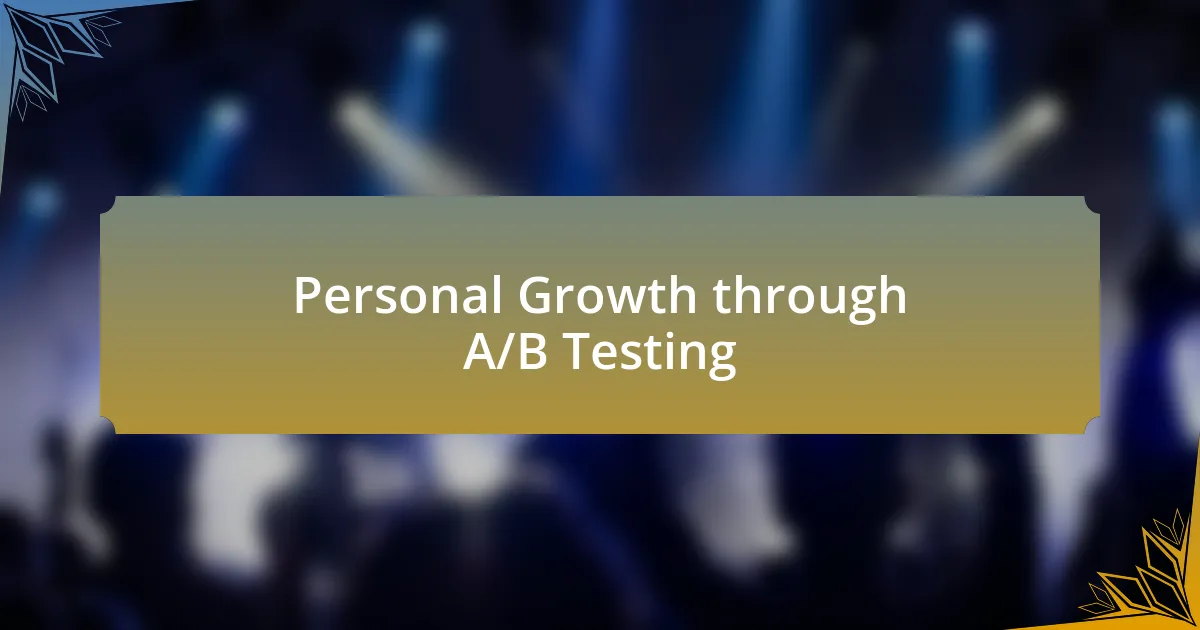Key takeaways:
- A/B testing is a straightforward method to compare webpage versions and enhances understanding of customer preferences through real-time data.
- Collecting customer feedback is crucial for identifying pain points and making impactful adjustments to improve user engagement.
- Insights from A/B testing can challenge assumptions, highlighting the importance of experimentation and adaptability in business strategies.
- Applying feedback effectively can lead to significant improvements in customer experience, demonstrating the value of being open to both positive and negative input.

Understanding A/B Testing Basics
A/B testing is essentially a way of comparing two versions of a webpage to see which one performs better. I remember when I first started experimenting with A/B tests on my own website; I felt like a scientist in a lab, excited to uncover which headline would draw in more clicks. Isn’t it fascinating to think that a simple adjustment can lead to significant changes in user behavior?
The beauty of A/B testing lies in its simplicity and the clarity it provides. You create two variant designs, label them as A and B, and then direct half of your traffic to each. It’s empowering to witness real-time data unfolding before your eyes, transforming your approach to understanding customer preferences.
One common question I often encounter is, “How long should I run my tests?” From experience, I’ve found that duration can vary greatly based on traffic volume and conversion goals. If you rush the process, you might miss crucial insights. Take a step back, allow enough time for the results to stabilize, and trust the data to guide you in making informed decisions.

Importance of Customer Feedback
Customer feedback serves as a vital lifeline for any business striving to enhance its customer experience. I recall a time when I implemented feedback mechanisms on my website, only to discover that a small adjustment in wording dramatically improved user engagement. By actively listening to customers, businesses can pinpoint pain points that might otherwise go unnoticed.
The beauty of gathering customer opinions lies in the actionable insights it provides. For example, when I received feedback indicating that my site’s navigation was confusing, it prompted me to conduct a thorough review and overhaul. This not only boosted satisfaction but also led to increased retention rates. Would you believe that something as simple as asking for input can unlock such transformative changes?
Every piece of feedback is a treasure trove of information waiting to be explored. During a recent customer survey, one open-ended response stood out, highlighting a feature I had previously overlooked. I had always been focused on major changes, but this small tweak made a big difference. It’s moments like these that reinforce the power of listening and adapting, ensuring that the customer experience remains at the forefront of decision-making.

Key Insights from A/B Testing
A/B testing provides invaluable insights into customer behavior, revealing preferences that can shape future strategies. I remember running an A/B test on two different landing page designs. The results were eye-opening; the version with a more streamlined call-to-action not only led to a 25% increase in conversions but also highlighted how small visual changes can drive significant results. Have you ever considered how even minor adjustments can greatly impact user decisions?
Analyzing A/B test data can be emotionally charged, especially when the findings challenge preconceived notions. After testing different email subject lines, I was surprised to discover that a casual, friendly tone outperformed a more formal approach. This experience taught me that my assumptions weren’t always aligned with my audience’s preferences. Isn’t it fascinating how our perceptions can sometimes blind us to what customers truly want?
The key takeaway from A/B testing is the importance of experimentation and adaptability. What I’ve learned is not just to rely on analytics but also to feel the pulse of user interactions. I once hesitated to implement a new feature based on data that suggested it wouldn’t work, only to find it became one of my customers’ favorites. This experience reaffirmed my belief that taking calculated risks is essential in cultivating a responsive and engaging customer experience.

Personal Growth through A/B Testing
Embracing A/B testing has not only refined my understanding of customer preferences but has also sparked significant personal growth. I vividly recall when I dived into testing various call-to-action phrases on our website. The moment I realized a simple switch from “Buy Now” to “Get Yours Today” significantly increased click-through rates left me in awe. It made me realize that being open to change is vital, and the ability to pivot quickly contributes to our overall success. Who knew that just a few words could evoke such a compelling emotional response?
Another profound lesson emerged when I tested two different layouts for a feedback form. I had always leaned towards minimalism, believing that less was more. However, the A/B test indicated that a more detailed layout with specific prompts resonated better with users. This revelation was a turning point for me. It forced me to confront my biases about design aesthetics and encouraged me to seek feedback actively, not just assume what works. Isn’t it remarkable how A/B testing can challenge our established beliefs and encourage us to rethink our approaches?
Through A/B testing, I’ve learned that failure can be just as enlightening as success. I once launched a campaign that I thought would be groundbreaking, only to learn it fell flat during testing. Initially, it felt disheartening, but upon reflection, I recognized the value in understanding what went wrong. This realization pushed me to view every setback as an opportunity for growth, enhancing my resilience and adaptability in future endeavors. How can we convert our disappointments into stepping stones for future success?

Applying Feedback to Improve Experience
Applying feedback is where the real magic happens in enhancing customer experiences. I still remember a time when feedback from a usability test revealed that users struggled to find the FAQ section on our site. With this insight, I felt compelled to reposition the link more prominently on the homepage. Not only did we see an increase in user satisfaction, but the overall navigability of our site improved significantly. Isn’t it astounding how straightforward changes can lead to such a difference?
In another instance, after implementing real-time chat support, the feedback poured in. Customers appreciated the immediate assistance, yet many expressed frustration about long wait times during peak hours. This constructive criticism encouraged me to explore chatbots for basic inquiries. The inclusion of a supportive chatbot not only streamlined the process but also ensured that our human agents could focus on more complex queries. This adjustment taught me that utilizing feedback isn’t just about addressing concerns—it’s about continuously evolving for optimal customer satisfaction.
There’s a deeper lesson in truly listening to feedback. I once organized a focus group, fully expecting to hear the positive aspects of our newest feature. Instead, participants candidly shared their frustrations. Initially, it felt like a punch to the gut, but I soon realized that this feedback was a gift. It was a chance to understand our audience on a deeper level. Isn’t it crucial to be open to hearing what we don’t want to hear? This willingness to embrace honesty has been invaluable in driving meaningful improvements.

Lessons Learned for Future Testing
When reflecting on future A/B testing, I learned the importance of setting clear metrics for success before launching. I remember a project where we felt confident about a design change without a solid performance benchmark. After weeks of testing, we realized our improvements weren’t as significant as we hoped. If only we had defined our goals more precisely, we could have made more informed decisions that aligned better with our customer needs.
Another valuable lesson came from revisiting our audience segmentation. During a test, we assumed that a single design would resonate with all user types, and I felt naïve when the results showed varied responses. This experience highlighted the need for tailored approaches based on distinct customer profiles. Have you found yourself falling into the trap of a one-size-fits-all solution? It was a wake-up call, reminding me that understanding our audience deeply can lead to more effective testing outcomes.
Finally, patience has become a crucial part of my testing philosophy. I once rushed to analyze results, convinced we needed immediate changes. I quickly realized that giving our data the necessary time to breathe could reveal trends we overlooked. Isn’t it fascinating how valuable insights often emerge with a little patience? By allowing the data to settle, I’ve learned to trust the process and truly commit to understanding our customers’ experiences over time.